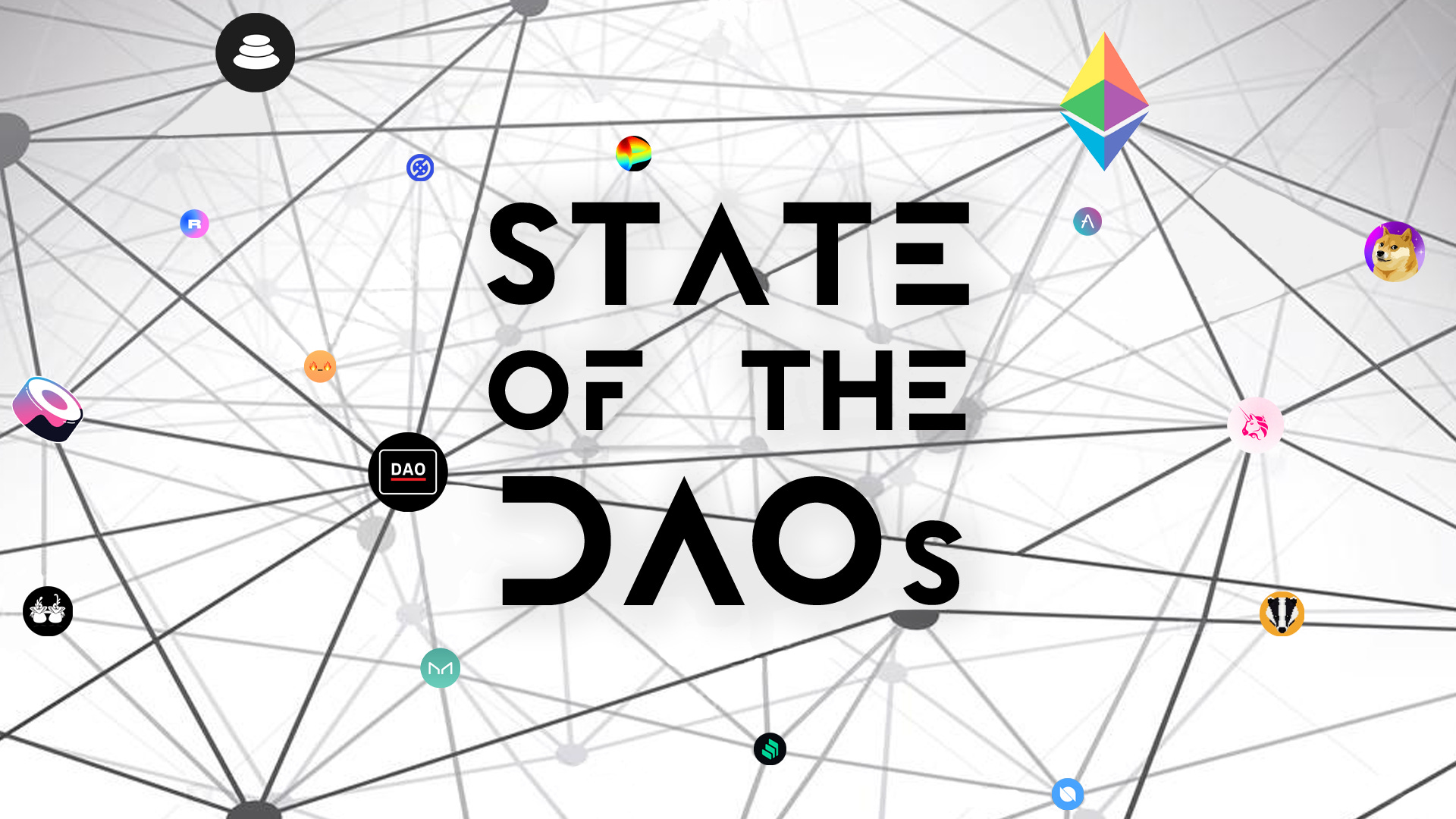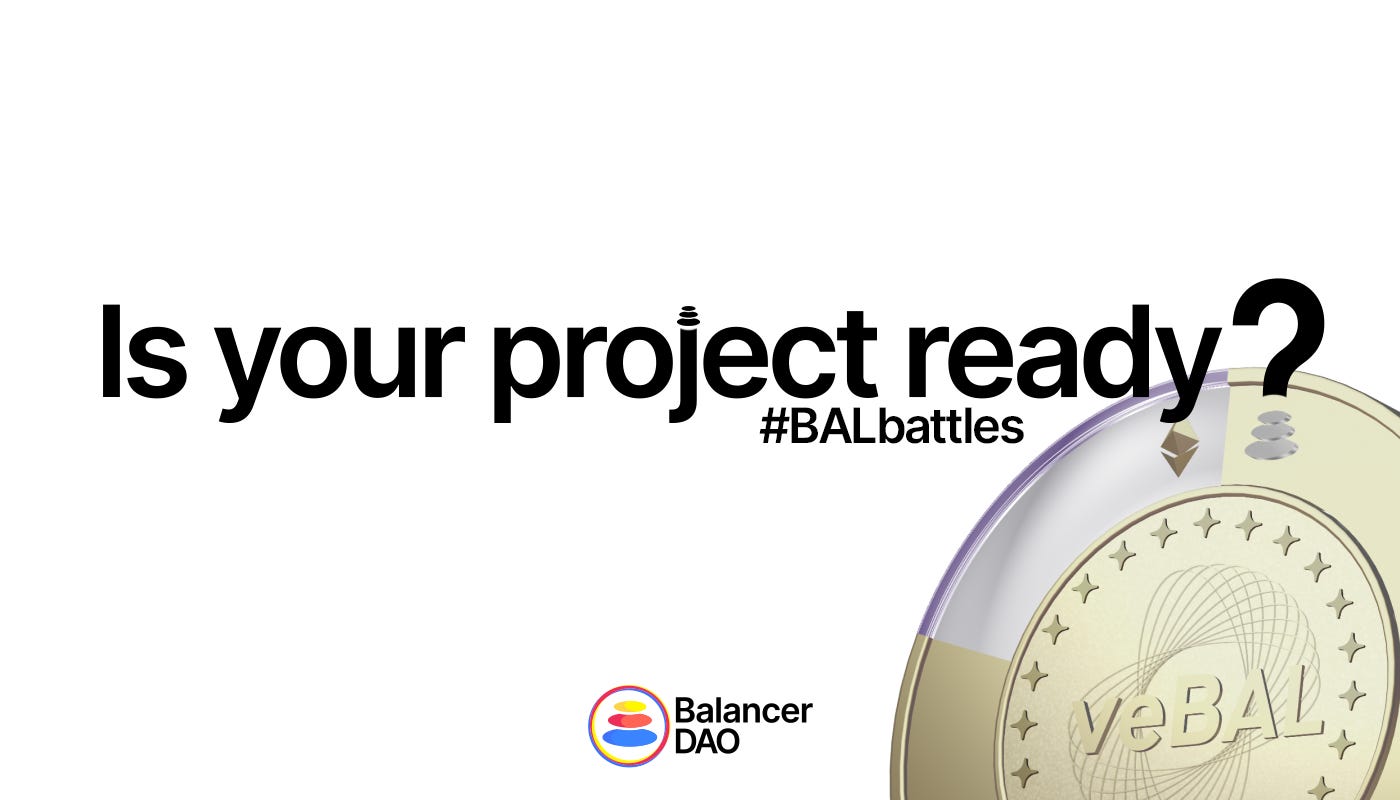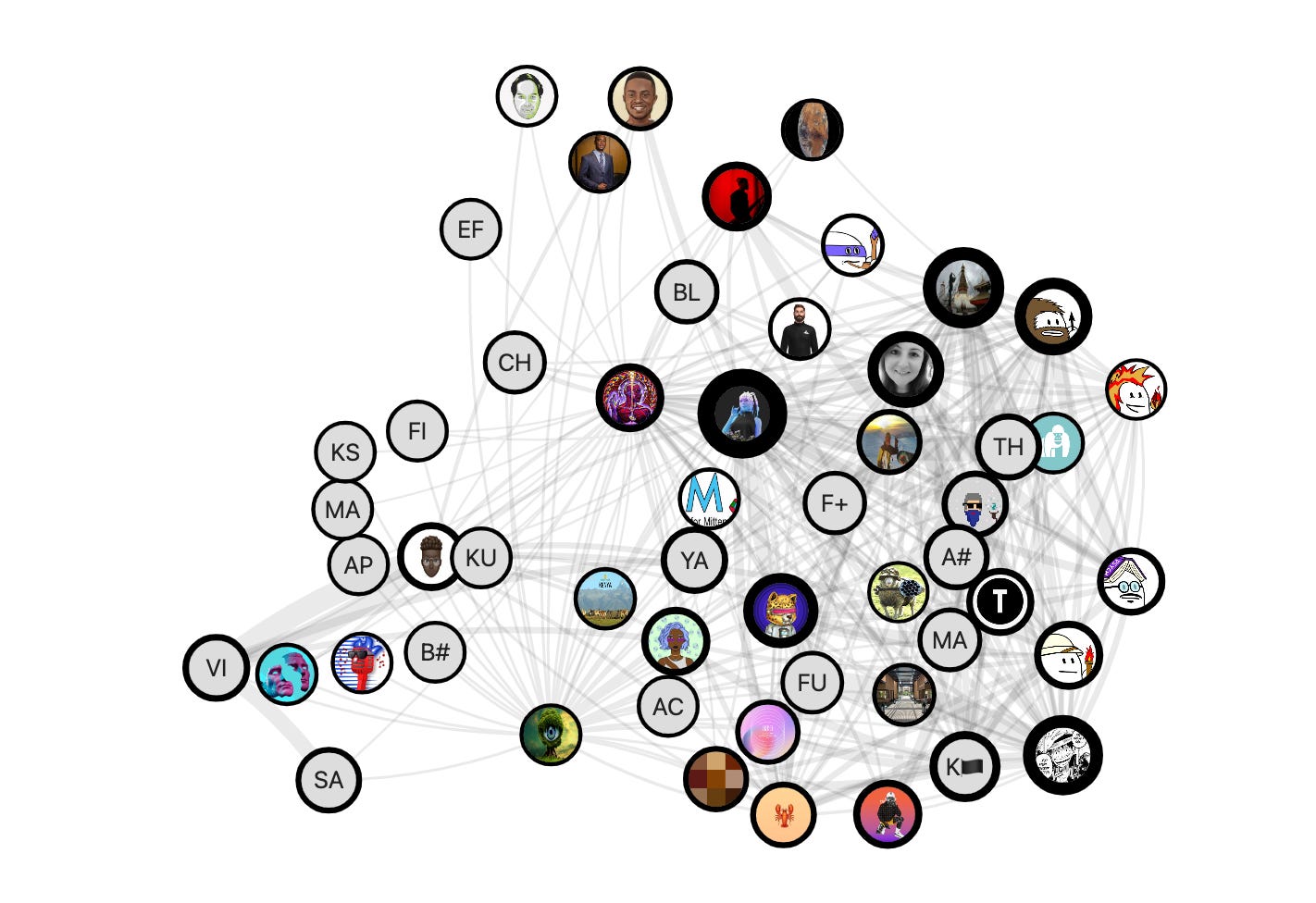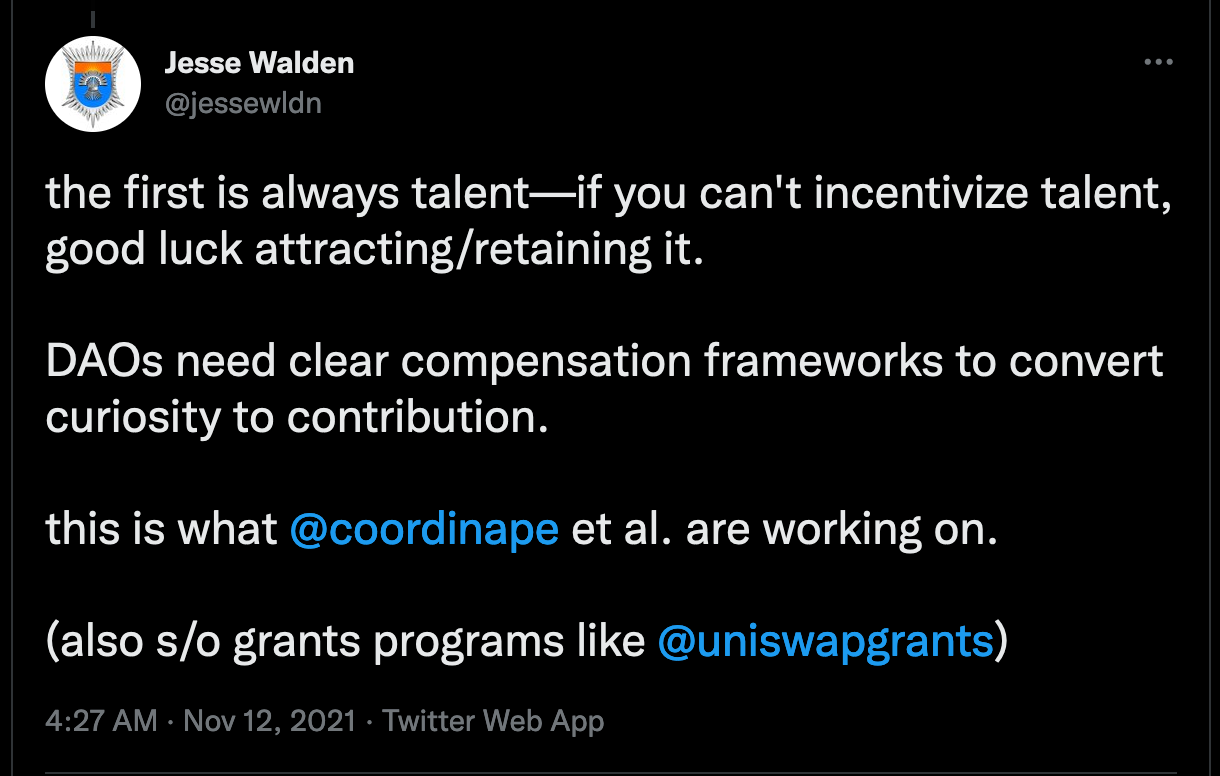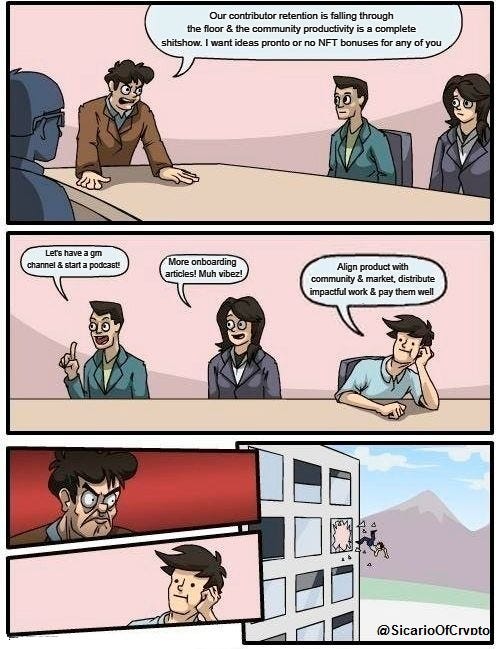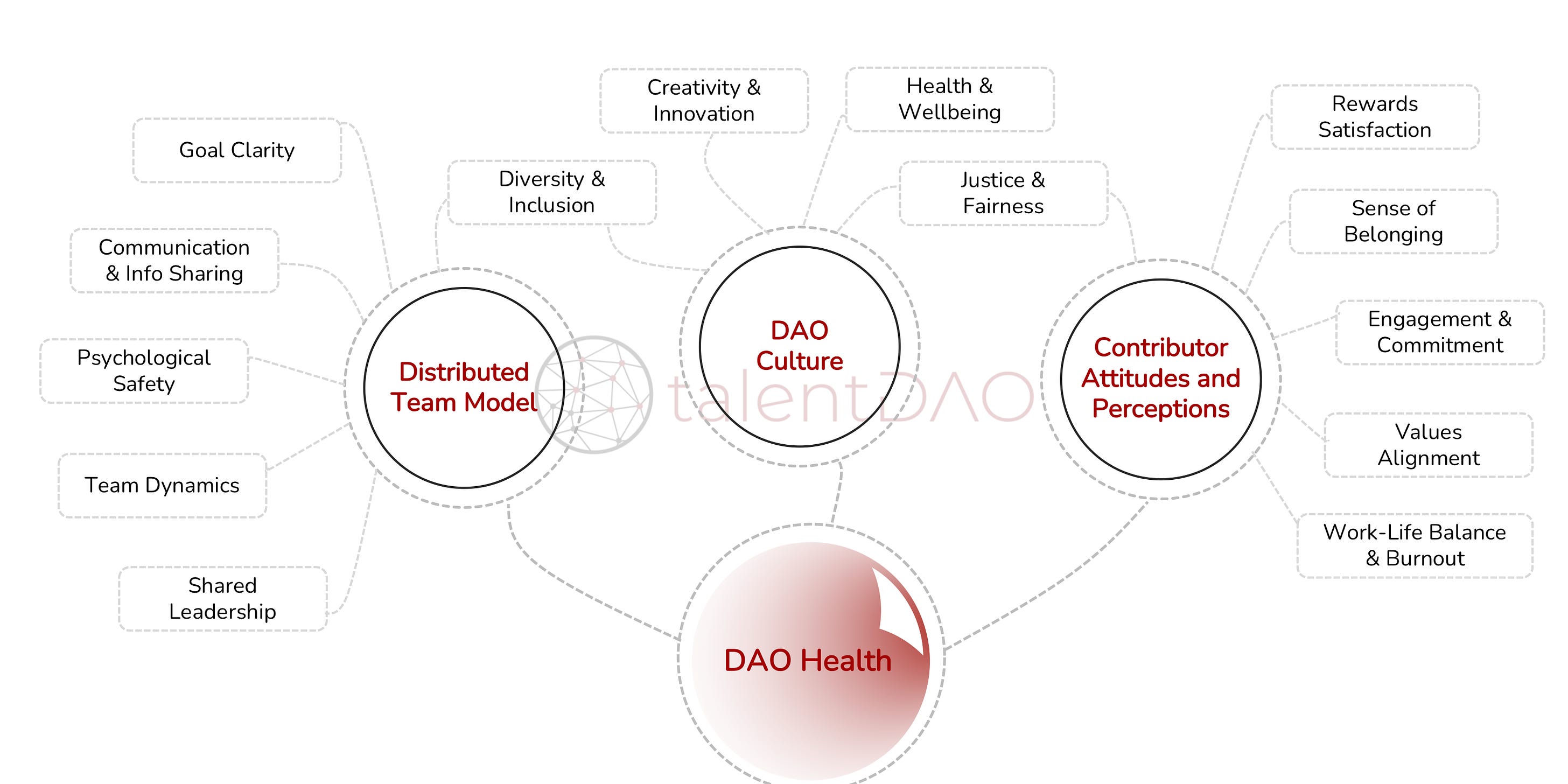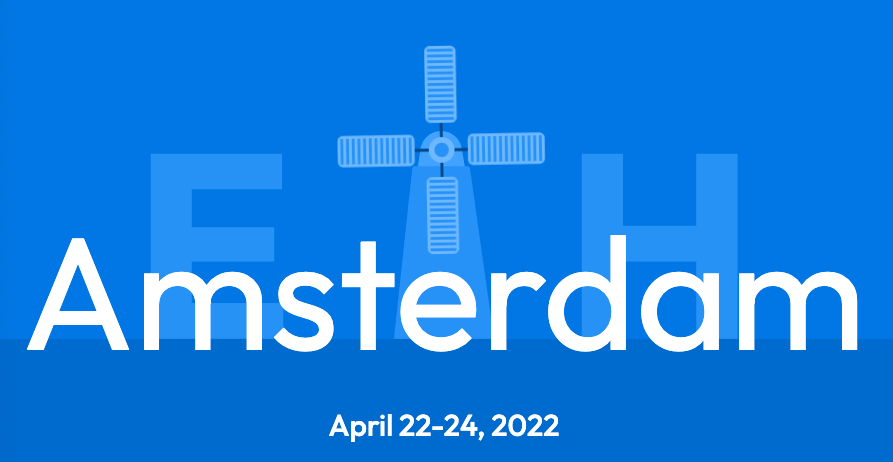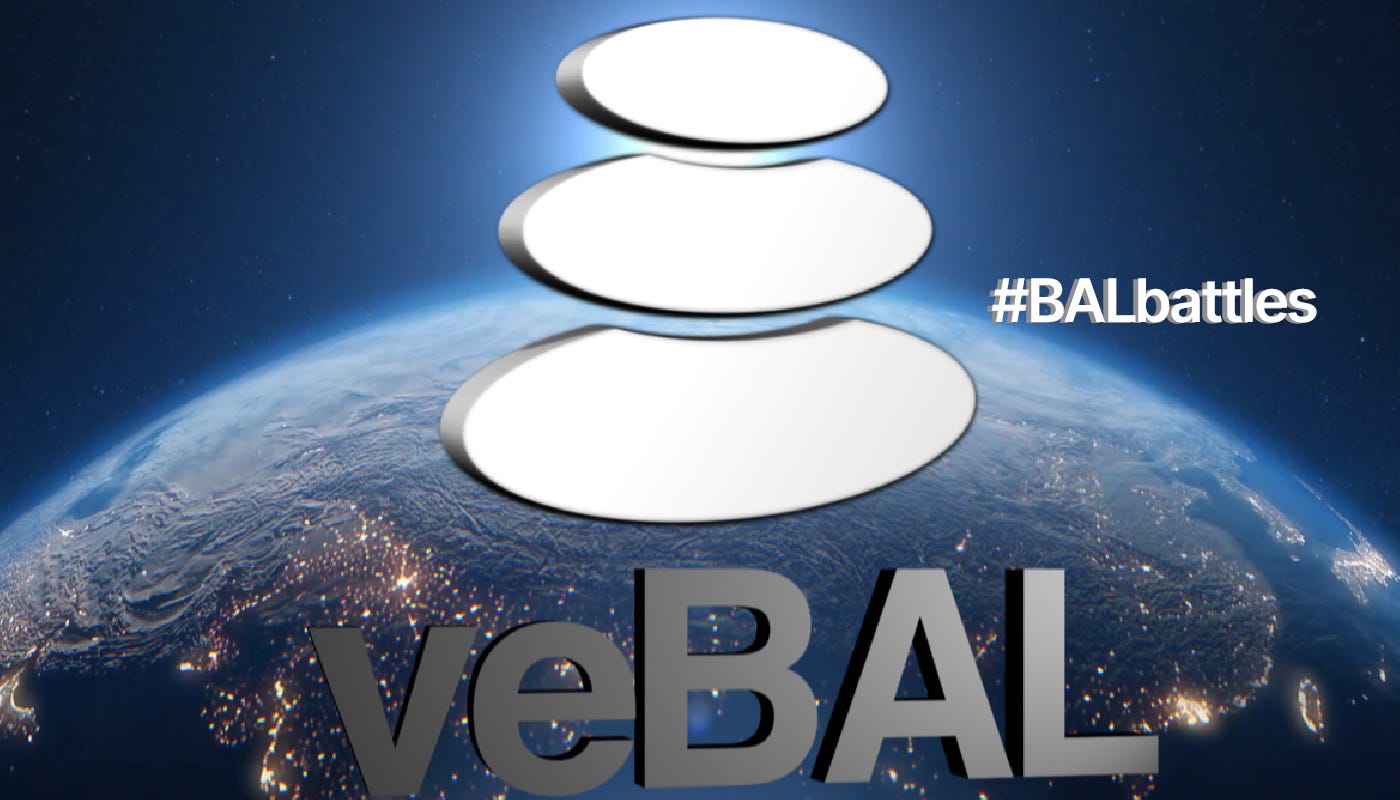Having The Hard Conversation: Building Better Compensation Frameworks in DAOs
Having The Hard Conversation: Building Better Compensation Frameworks in DAOsYou're reading State of the DAOs, the high-signal low-noise newsletter for understanding DAOs.Gm and welcome to DAOlife! It’s time for us to have “The Talk”... When the vibes are high and the music is loud, it’s easy to ignore about things like roles, vacation, and compensation, but Samantha Marin is here to have an adult discussion with us about how to maintain contributors and build better compensation structures. Next, we share the TL;DR on the latest DAO ecosystem takes and thought pieces, making it easy for you to cut through the noise and stay up to date on the world of DAOs. This is the current state of the DAOs. Contributors: BanklessDAO Writers Guild (Alvo von A, d0wnlore, jaux, Kaf, teeleroo, hirokennelly.eth, siddhearta, Jake and Stake) This is the official newsletter of BanklessDAO. To unsubscribe, edit your settings. 🙏 Thanks to our Sponsor Having The Hard Conversation: Building Better Compensation Frameworks in DAOs
In corporate life, figuring out compensation is usually pretty easy. Someone at the top of the chain tells someone in the middle of the chain what your bottom of the chain job should be paid. If you’re entering mid-chain, there might be a little negotiation in between. Maybe a little extra stock or bonuses if you sell yourself well. In DAOs, figuring out compensation is usually really, really hard. Because there’s not a top-down approach to compensation, the community must determine who gets paid what. And this gets pretty tricky, because not everyone knows what others are up to, and decision-making moves slowly in a large group. But compensation is also one of the most important things to consider. There are more opportunities than ever that are pulling skilled contributors away from your DAO and toward someone else’s. The compensation talk, aka “The Hard Conversation”, is one of the, newsflash, hardest things we’ve been trying to figure out in BanklessDAO, and I know it’s been a barrier for other DAOs, too. Peer-allocation systems like Coordinape can solve some of these issues, but delineating a full salary off of what someone is allocated via GIVE tokens is probably not gonna cut it when it comes to attracting top-notch talent. Here’s my attempt at having The Hard Conversation based off many other Hard Conversations I’ve lurked in or been part of. Start with a basic remuneration outline that internal projects can build from (but not too basic).People work better if they have a general idea of the constraints they’re working within. Those constraints can be wide or narrow—but there should be something for people to work within. So the first thing you should do is build this framework. One way I’ve seen this framed is as “recipes, not instructions.” Rafael, core contributor at Cabin, wrote that “it’s probably best to think about community guidance as contextual (artistic!) recipes while encouraging individual members and guilds to find the right solutions for their context.” For example, in BanklessDAO we started with a set token-per-hour remuneration instruction which can now evolve into a recipe with a lot of room for extra spices. Contributors were seeking the nuance but didn’t have a framework to test the nuance in. What about one-off bounties where hourly effort wasn’t recorded? What about contributors’ different speeds of working? What about participation in synchronous meetings? Should some difficult, essential tasks be valued higher than other easier, less-essential ones? The hourly rate estimate was a good start, but not enough of a flexible framework to work within. We quickly saw projects and guilds start building their own remuneration frameworks. Some shot for the moon with their funding asks, while others seemed to be pinching gwei. I’ve been told that I could’ve asked for more funding in some situations, and found myself wondering how I could have possibly known that. This left a heavy burden on our funding processes and created an environment where it was too hard to say no to projects. But, as we grow and iterate, we’ll be coming up with new funding structures and frameworks for our projects to use. Here are a couple funding frameworks that could be applied in any DAO:
Build roles that have small remuneration decision-making abilities baked in.People sometimes think DAOs are completely flat organizations where everyone makes every decision together. Those people have never been in a DAO. Roles should have a level of remuneration decision-making ability baked in. A role-holder might have the ability to create and set bounties for tasks that are related to the role. A Design Lead could set remuneration structures for one-off POAP designs, for example. Since they would best know the scope of work for those bounties, they should be allowed to set the remuneration structure for them. But the remuneration abilities should be limited. Should the role-holder be able to set someone else’s base compensation or salary entirely by themselves? No. But giving some compensation-setting power, especially with bounties, could be a huge unlock for DAOs experiencing decision fatigue and contributor burnout. There should be rails, but those rails should allow experimentation and ideation. Without clearly-compensated roles with bounty and even sub-role-creating abilities, bounty hunters and non-role-holders suffer. They get paid too little or too much. They don’t know when to pick up a bounty because they’re not sure if it will be worth their time. Roles with remuneration abilities inside them must be designed for the well-being of workers picking up those bounties, not the role-holders themselves. Create a salary for full members to encourage time off, essential governance tasks, and deep work.Many of the DAO’s most active members don’t actually have a role—they’re compensated for their work via bounties and Coordinape rounds. But this encourages members to only pick up work they can turn around quickly, so they can pick up another task. In other words, it incentivizes fast work rather than slow, methodical, deep work. A salary for the DAO’s most active members is a solution to this problem. This is similar to DAOhaus’s base and bonus system: contributors are paid a base salary but receive bonuses via Coordinape for above-and-beyond work.
By providing full members with a salary, these members are incentivized to stay in the DAO and continue working on the DAO. If the member only works part-time in the DAO, they get a part-time salary or salary. Once salaries are set, the DAO can then ask members to:
Members who receive salaries should still pick up bounties, participate in Coordinape, and hold roles. The salary is what will keep the members around and increase the stickiness of the DAO. Couldn’t members abuse this? Yes. People in Web3 are smart and can figure out how to exploit almost anything. That’s what makes this whole thing fun, right? Luckily, we are also smart and know how to get around the exploiters. Here are some options:
Salaries solve a lot of problems. But, like anything new and experimental, they create some problems, too. I’m excited to follow the DAOs that are testing base compensation and salary within their ranks to see what we can learn from them. Limit Coordinape rounds to small circles of people who work together to prevent the dreaded popularity contest.Coordinape is fun. But it only works if everyone is actually working together. Our small Coordinape rounds are very effective. Everyone knows what others have been working on, so they can easily allocate GIVE tokens without guessing. But the DAO-wide Coordinape is not nearly as effective. Less outspoken individuals get the short end of the stick, while people who traffic a lot of channels end up getting more tokens. Sometimes, trafficking more channels means you have been working on and in the DAO more. But….sometimes it doesn’t. Coordinape rounds should be small, held amongst project and department groups only. Remuneration structures suffer when people don’t know who they’re remunerating or what they’re remunerating them for. Coordinape is a great method for DAO remuneration, but should only be used as bonuses and only within groups who know each other and work together.
Encourage projects to iterate on the DAO’s remuneration outline and share their findings so the whole DAO can improve.Within projects and guilds (guilds in BanklessDAO are half corporate department, half professional association), there has been iteration on the hourly funding structure. But we haven’t been very good at sharing it. It’s no one’s direct fault—we’re all heads down, working. But, for DAOs to learn how to successfully compensate contributors, they must become better at sharing it. Large DAOs are lucky to have so many SubDAO experiments happening inside them. But, we need to set standards in which those mini experiments can happen and report findings without feeling as if they’re going against the wishes of the larger DAO. Experimentation is necessary at this early stage in DAOs. However, the experiment must be documented in a standard template so members can easily take key learnings from it. Experiments that aren’t documented and shared are wasted. One solution for this is to create a compensation or funding team that dives deeply into each project’s funding structure at the end of each cycle or season. Even a simple feedback form can do wonders when it comes to identifying how SubDAO funding experiments are panning out. DAOs are performing tons of interesting experiments, they just need to document them. Design compensation frameworks to keep talent in-house, rather than bleeding talent to DAOs with more sophisticated frameworksWithout the requisite perks needed to keep them at the DAO, highly skilled members can and will take their skills elsewhere. If DAOs don’t acknowledge that membership retention must be of utmost priority, they will lose people who have and could have become core members.“DAOs should create ways for contributors to make longer term commitments, and even encourage and incentivize such commitments as a way of retaining their talented contributors,” wrote Spencer Graham, core contributor at DAOhaus, in a piece for The Defiant. In other words, paying contributors to stick around helps them make the decision to actually stick around. The Dead Sea Effect is when an organization has a hard time keeping highly skilled members, because those individuals naturally have more opportunities available to them. If the organization doesn’t meet their needs, it’s easy for them to go elsewhere. So, the organization gets left with the people who don’t have opportunities elsewhere, kind of like the salt in the Dead Sea. If you work in a DAO, the Dead Sea Effect should scare you. It might even be the biggest problem a DAO needs to tackle in order to survive more than six months. It’s scary, but again, we have options. Tackling these problems looks like:
Don’t let your DAO become the Dead Sea. Set healthy compensation frameworks. Jesse Walden of Variant Fund put it succinctly: “if you can't incentivize talent, good luck attracting/retaining it.” I couldn’t agree more.
Educate contributors on how to talk about payment structures and take away the stigma of “money talk”DAOs wouldn’t be able to move forward without having these Hard Conversations. So, creating spaces where it’s encouraged to talk about compensation is essential. Some of these spaces include open discussion-style meetings, office hours, forums, and channels where the environment is calm and trusting rather than angry and hostile. Money talk can get uncomfortable fast, so consider voicing your concerns like this:
With these conversation tools, we can start having The Hard Conversations without feeling endlessly awkward about it. Which, honestly, could be the biggest unlock DAOs will have. They never said it would be easy….but it’s definitely worth it.Even though there’s still a ton to figure out about compensation structures, that doesn’t mean we shouldn’t put in the hard work to do it. The cloudy, secretive compensation structures of the corporate world are easy but damaging. Avoid the damage. Run toward hard things. We’re building a better system—we just need to put in the hard work and have the hard conversations to make it happen. Actions steps📖 Read How to get paid by DAOs | Lucas Campbell ⛏️ Dig into How We DAO: Cabin’s Media Guild Compensation Framework 🎧 Listen Payments for the Contributor Economy | Web3 Native Podcast 🙏 Sponsor: Balancer DAO- #BALbattles begin! DAOs at a Glance
How DAOs Could Change the Way We WorkAuthor: Steve Glaveski Technology has transformed the way we work and where we work. The Industrial Revolution brought farmers indoors to assemble machines in factories, and further automation created a wave of administrators carried out work in offices. As the World Wide Web further envelops our lives, it’s natural to expect more changes on the horizon, and DAOs will begin shaping the way work will look like in the future. The tech-forward nature of web3 means that algorithms and automation are freely embraced, so in time, work there will be more about the creativity and less about monotonous tasks. It's said that 85% of today’s global workforce is disengaged, but DAOs provide contributors the opportunity to choose among initiatives that resonate with their values and match their talents. Because these groups are coordinated online, they provide increased geographical flexibility. Perhaps these features will alleviate the stresses of work-life imbalances, lack of autonomy, and office politics. They might make it more difficult for traditional corporations to attract talent too. DAOs are governed by token holders, operating like most other digital assets in its ability to be traded or used as collateral across the crypto ecosystem. However, this means that the coins can also be purchased by non-contributors, complicating governance. Within the community, members earn these tokens by completing tasks or bounties, which drive the overall mission forward. While voting structures are likely to evolve over time, working on projects you care about and the ability to shape the direction of organization are will continue to shape future labor markets. Warm CryptoAuthor: Richard Kim Crypto has been one of the greatest generational wealth transfers in history, coming in various waves and laying the foundation for a modern industrial revolution. This started with digital currencies like Bitcoin, evolving into smart contract execution layers like Ethereum. The creation of Ethereum and alternative Layer 1s unlocked more creative uses of tokens: DeFi, NFTs, Play2Earn, and community tokens. The most recent bull-run has softened the general public to the ideas of self-sovereignty, pseudonymity, and decentralization, parts of the crypto ethos that may have been unpalatable to all but the most stalwart explorers. But as the crypto ecosystem progressed, we’ve created an environment of chasing short-term money and status games, which are an unfortunate byproduct of the “moneyness” of tokens. While the first waves in crypto caused friction in the ecosystem's path towards mass adoption, we’re facing the threat of building a “cold” crypto ecosystem, one that is too exclusive, isolating, scarce, trustless, and rife with zero-sum games. If we are going to build money and status games, we need to make them sustainable and help support the effort of building lasting communities that connect to our broader humanity. This is how we unlock “warm” crypto. Optimal autonomous organizationsAuthor: Curtis Yarvin DAOs are here, but they are immature, and have not yet been subject to the ruthless optimization that is the modern corporation. As the joint-stock ownership company came to dominate business, it refined it’s decision-making practices to near optimal. In its current organizational form, a DAO cannot compete with this. But an optimal autonomous organization (OAO) can. In OAOs, the goal of governance token holders should not be conflicted—governance decisions are solely focused on the success of the organization—regardless of how that organization defines success. The fundamental motivation for designing an OAO is to bring a streamlined version of corporate governance on chain. The OAO is designed to maximize efficiency and accountability. These optimized organizations achieve autonomy by running decision-making on chain and by bestowing anonymous trustees with the power of the purse and the ability to make changes to governing structures, including the executive(s) who runs the OAO. The OAO must first define its mission, then actions taken outside the mission should be seen as problematic and rebuked by a trustee. An OAO is really like a corporation running on a blockchain, but with certain corporate inefficiencies eliminated. Retained, however, is the corporate-like management structure that has made the modern corporation so effective. In DAO v. Corp, the corporation will always win. OAOs give the blockchain a chance. How to Drive Business Growth By Fostering Your CommunityAuthor: Patrick Woods Businesses must invest in the community. A Go-to-Market (GTM) strategy involves figuring out who it is you’re selling your product to and using your resources to convince them that your product’s value-proposition is worth taking, but today, having a “Go-to-Community” (GTC) strategy is equally important. This is the process of implementing and optimizing your community building efforts to match business objectives. The key is to create value with and for them instead of capturing value from them. A good way to guarantee success is to do community discovery. Through these phases: Awareness, Acquisition, Activation, Retention, Product and Referral, the user can become familiar with the product through word of mouth and continue to propagate of the mission. Introducing Incentives Into CommunitiesAuthor: Mark Baylin Incentives encourage or motivate people to participate in certain communities and these incentives can be extrinsic, intrinsic, or both. Some problems can emerge when the interests of the community are no longer aligned with the incentives of the core contributors. When changes are not made, core distributors will look for more attractive opportunities. But if the DAO swings too far in the opposite direction, it risks attracting contributors that only seek monetary incentives, and mission-aligned contributors may be pushed to the margins or leave entirely. Typically, the incentives of online communities progress from having zero incentives, to utilizing reputation as an incentive, and, ultimately, to using monetary payments as an incentive. There is also a middle step where contributors earn “sweat equity” (ownership of a company that hasn’t gotten any money) which is a healthy step in the sequence of community growth. Ecosystem Takes
 Jeff Kauffman: DAOs Will Own Big BrandsAuthor: Jeff Wilser 🔑 Insights: Jeff Kauffman has been online community building since Web1, when there was a genuine communication channel between brands and their customers. This relationship soured when the large Web2 companies gained more power and changed the rules. Kauffman exited the scene and emerged in Web3 to launch JUMP, a community for marketing and advertising professionals. From his vantage point as someone who runs bootcamps for crypto newcomers, he is able to identify future trends.
Decentralization for Web3 Builders: Principles, Models, HowAuthor: Miles Jennings 🔑 Insights: The promises of decentralization are often debated. However, with the advent of programmable blockchains, composable smart contracts, and digital assets, developers have the tools to create community-centric ecosystems at scale. There are unique, but interrelated design challenges associated with building a distributed web3:
Cultivating Catalytic CommunitiesAuthor: Sarah Campbell 🔑 Insights: CULTIVATING CATALYTIC COMMUNITIES It is important to cultivate catalytic communities because to address systemic issues all parts of the system must work together. These communities bring together different actors to solve issues collectively, share information and resources freely, and coordinate and collaborate effectively.
Developing the DAO Health Survey: an open-source tool for web3 organizational effectivenessAuthor: k3nn.eth 🔑 Insights: The collective psychological health of a DAO can be propel organizations into the future or lead to a negative feedback loop. The talentDAO has created a DAO Health survey on Github that DAOs can use to improve contributor experience and the resultant outcomes of the DAO.
DAO Spotlight: [REDACTED] Cartel DAO[REDACTED] Cartel DAO is participant in the Curve wars. A relatively new project launched in December 2021, [REDACTED] is an Olympus fork that utilizes protocol owned liquidity to control where incentives are funneled. Users can lock their governance tokens (BTRFLY) in the Hidden Hand protocol for 16 weeks and earn rewards in the form of the bribes captured by the protocol. The cartel is building a large stockpile of important DeFi Governance tokens to generate yield for cartel members. The team has developed smart contract protocols to provide “Bribe Voting” capabilities like in Hidden Hand. Fees captured by the protocol are distributed between the treasury and BTRFLY holders. Locking BTRFLY into the new offerings will allow you to receive rewards. Be on the lookout for Pirex. Pirex is similar to Convex, but provides users liquidity for their locked-up tokens. As with many new projects, you could get rekt, so proceed with caution! Keep up with the projects by visiting their website, joining the Discord, or following them on Twitter! Get Plugged InEvent HighlightsBanklessDAO - Permissionless Conference - Tickets just went on sale for one of the biggest DeFi conferences! Over 5,000 people will be attending in total and every two weeks 250 more tickets are unlocked. Once 250 tickets are purchased, registration closes and you’ll have to wait until the next release. Speakers include our very own Ryan Sean Adams and David Hoffman, as well as many others. Join us on Tuesday - Thursday, May 17 - 19, 2022 in sunny Palm Beach, Florida for the event. All over the world, hundreds of thousands of developers, users, hobbyists, creators, artists, and market makers spend their days and nights thinking, building, talking about Ethereum because we are... excited. We're excited by the idea that Ethereum can change things. That Ethereum is a fulcrum we can use to change money, finance, the web, ownership, the way software works and the way power is distributed. 🧳 Job OpportunitiesGet a job in crypto! Do you like solving hard problems, care about building more efficient markets for everybody, and want to work at the frontier of decentralized finance? KeeperDAO is looking for full time contributors, with salaries ranging from $169,000-$722,000. There are positions ranging from engineering, recruiting, product marketing, copywriting, and design. Sound interesting? Sign up for our referral program and go full-time DAO.
🙏Thanks to our SponsorBalancerBalancer is a flexible and versatile Automated Market Maker that enables efficient trading and the exchange of any combination of ERC-20 tokens permissionlessly. Balancer also turns the concept of an Index Fund on its head: instead of paying fees to Portfolio Managers, you can now collect fees from traders who rebalance your portfolio by following arbitrage opportunities. The Balancer Protocol is a core building block of DeFi infrastructure — a unique financial primitive and development platform. If you liked this post from BanklessDAO, why not share it? |
Older messages
Bored Apes and Polygoonz and Legends of Cypher, oh my! | Decentralized Arts
Monday, April 18, 2022
BanklessDAO Weekly NFT and Cryptoart Newsletter
Science Fiction Comes to the Metaverse | Decentralized Arts
Monday, April 11, 2022
BanklessDAO Weekly NFT and Cryptoart Newsletter
Shaping Season 4 | BanklessDAO Weekly Rollup
Saturday, April 9, 2022
Catch Up With What Happened This Week in BanklessDAO
Funding the Future through Scholarship DAOs | State of the DAOs
Friday, April 8, 2022
You're reading State of the DAOs, the high-signal low-noise newsletter for understanding DAOs.
Funding the Future through Scholarship DAOs | State of the DAOs
Wednesday, April 6, 2022
You're reading State of the DAOs, the high-signal low-noise newsletter for understanding DAOs.
You Might Also Like
Monthly Update on Blockchain Technology: Pectra testnet activation, zero-knowledge gossip, BNBChain roadmap
Thursday, March 6, 2025
Written by: GaryMa, WuBlockchain ͏ ͏ ͏ ͏ ͏ ͏ ͏ ͏ ͏ ͏ ͏ ͏ ͏ ͏ ͏ ͏ ͏ ͏ ͏ ͏ ͏ ͏ ͏ ͏ ͏ ͏ ͏ ͏ ͏ ͏ ͏ ͏ ͏ ͏ ͏ ͏ ͏ ͏ ͏ ͏ ͏ ͏ ͏ ͏ ͏ ͏ ͏ ͏ ͏ ͏ ͏ ͏ ͏ ͏ ͏ ͏ ͏ ͏ ͏ ͏ ͏ ͏ ͏ ͏ ͏ ͏ ͏ ͏ ͏ ͏ ͏ ͏ ͏ ͏ ͏ ͏ ͏ ͏ ͏ ͏ ͏ ͏ ͏ ͏
Reminder: White House Schedules First Ever Crypto Summit
Thursday, March 6, 2025
March 3rd, 2025 Sign Up Your Weekly Update On All Things Crypto TL;DR White House Schedules First Ever Crypto Summit SEC Declares Meme Coins Are Not Securities Consensys Secures Victory In MetaMask
Donald Trump to reportedly unveil Bitcoin reserve strategy at White House crypto summit
Wednesday, March 5, 2025
Key industry figures, including Michael Saylor and Brian Armstrong, to join Trump at White House crypto summit. ͏ ͏ ͏ ͏ ͏ ͏ ͏ ͏ ͏ ͏ ͏ ͏ ͏ ͏ ͏ ͏ ͏ ͏ ͏ ͏ ͏ ͏ ͏ ͏ ͏ ͏ ͏ ͏ ͏ ͏ ͏ ͏ ͏ ͏ ͏ ͏ ͏ ͏ ͏ ͏ ͏ ͏ ͏ ͏ ͏
DeFi & L1L2 Weekly — 🚀 Cronos pioneers seamless crypto-to-debit transfers; Virtuals Protocol saw a 95% drop in tr…
Wednesday, March 5, 2025
Cronos pioneers seamless crypto-to-debit transfers. Virtuals Protocol saw a 95% drop in trading volume. Ondo Finance joined the Mastercard network to improve cross-border payments. ͏ ͏ ͏ ͏ ͏ ͏ ͏ ͏ ͏ ͏
DeFi & L1L2 Weekly — 🚀 Cronos pioneers seamless crypto-to-debit transfers; Virtuals Protocol saw a 95% drop in tr…
Wednesday, March 5, 2025
Cronos pioneers seamless crypto-to-debit transfers. Virtuals Protocol saw a 95% drop in trading volume. Ondo Finance joined the Mastercard network to improve cross-border payments. ͏ ͏ ͏ ͏ ͏ ͏ ͏ ͏ ͏ ͏
Global Crypto Mining News in February:U.S. Customs Increases Scrutiny of Chinese Bitcoin Mining Machines, Bitdeer …
Wednesday, March 5, 2025
1. Bitfarms said it is exploring ways to enter the artificial intelligence and high-performance computing space, as bitcoin miners continue to explore alternatives following last April's bitcoin
Crypto traders lose nearly $1 billion as US-China trade war overshadows Trump’s crypto reserve initiative
Tuesday, March 4, 2025
US trade tensions with China and allies spark $500 billion crypto market plunge despite Trump's crypto reserve plan. ͏ ͏ ͏ ͏ ͏ ͏ ͏ ͏ ͏ ͏ ͏ ͏ ͏ ͏ ͏ ͏ ͏ ͏ ͏ ͏ ͏ ͏ ͏ ͏ ͏ ͏ ͏ ͏ ͏ ͏ ͏ ͏ ͏ ͏ ͏ ͏ ͏ ͏ ͏ ͏
Analyst Spotlight Solana Overview
Tuesday, March 4, 2025
An in-depth look at Solana (SOL) and this week's market developments ͏ ͏ ͏ ͏ ͏ ͏ ͏ ͏ ͏ ͏ ͏ ͏ ͏ ͏ ͏ ͏ ͏ ͏ ͏ ͏ ͏ ͏ ͏ ͏ ͏ ͏ ͏ ͏ ͏ ͏ ͏ ͏ ͏ ͏ ͏ ͏ ͏ ͏ ͏ ͏ ͏ ͏ ͏ ͏ ͏ ͏ ͏ ͏ ͏ ͏ ͏ ͏ ͏ ͏ ͏ ͏ ͏ ͏ ͏ ͏ ͏ ͏ ͏ ͏
ETH Denver Conference Impressions: VC Indifference, Lackluster Narratives, and the Disillusionment of Idealism
Tuesday, March 4, 2025
Compared to last year — and even more so than the recently concluded Consensus — the overall atmosphere was much more subdued, with panel speakers noticeably outnumbering the audience. ͏ ͏ ͏ ͏ ͏ ͏ ͏ ͏
Trump’s crypto reserve faces backlash over ADA and XRP inclusion
Monday, March 3, 2025
Ripple and Cardano leaders embrace Trump's multichain approach despite criticism for altcoin inclusion. ͏ ͏ ͏ ͏ ͏ ͏ ͏ ͏ ͏ ͏ ͏ ͏ ͏ ͏ ͏ ͏ ͏ ͏ ͏ ͏ ͏ ͏ ͏ ͏ ͏ ͏ ͏ ͏ ͏ ͏ ͏ ͏ ͏ ͏ ͏ ͏ ͏ ͏ ͏ ͏ ͏ ͏ ͏ ͏ ͏ ͏ ͏
